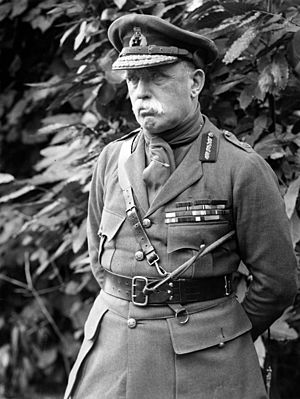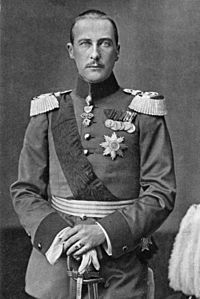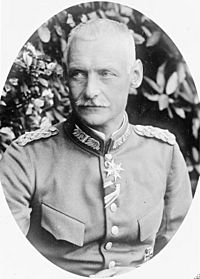First Battle of Ypres order of battle facts for kids
The First Battle of Ypres was a very important battle during the First World War. It happened from October 19 to November 22, 1914, in northern France and Flanders, which is part of Belgium. This battle was a big fight between the armies of the British Expeditionary Force (BEF), the French army, and the German Empire's army.
An "order of battle" is like a list of all the different groups and units that made up an army during a battle. It shows who was in charge and which smaller groups reported to them. This helps us understand how the armies were organized and who fought where.
Contents
British Forces in the Battle of Ypres
The main commander for the British forces was Sir John French. The British army was made up of several large groups called Corps, each with different divisions and smaller units.
I Corps (British Army)
This group was led by Douglas Haig.
1st Division
Led by Samuel Lomax, this division included:
- 1st (Guards) Brigade: Famous regiments like the Coldstream Guards and Scots Guards.
- 2nd Brigade: Regiments such as the Royal Sussex Regiment.
- 3rd Brigade: Included the Queen's Royal West Surrey Regiment.
- Artillery: Several brigades of Royal Field Artillery (RFA) and Heavy Batteries.
- Other Units: Mounted troops (like Hussars) and Royal Engineers.
2nd Division
Led by Charles Monro, this division had:
- 4th (Guards) Brigade: Grenadier Guards and Irish Guards.
- 5th Brigade: Worcestershire Regiment and Oxfordshire and Buckinghamshire Light Infantry.
- 6th Brigade: King's Regiment (Liverpool) and Royal Berkshire Regiment.
- Artillery: More RFA brigades and Heavy Batteries.
- Other Units: Mounted troops and Royal Engineers.
II Corps (British Army)
This group was led by Horace Smith-Dorrien.
3rd Division
Led by Aylmer Haldane, this division included:
- 7th Infantry Brigade: Worcestershire and Royal Irish Rifles.
- 8th Infantry Brigade: Royal Scots and Honourable Artillery Company.
- 9th Infantry Brigade: Northumberland Fusiliers and Royal Scots Fusiliers.
- Artillery: RFA brigades and a Heavy Battery.
- Other Units: Mounted troops and Royal Engineers.
5th Division
Led by Charles Fergusson, this division had:
- 13th Infantry Brigade: Kings Own Scottish Borderers and Duke of Wellington's Regiment.
- 14th Infantry Brigade: Suffolk and East Surrey.
- 15th Infantry Brigade: Norfolk and Bedfordshire.
- Artillery: RFA brigades and a Heavy Battery.
- Other Units: Mounted troops and Royal Engineers.
III Corps (British Army)
This group was led by William Pulteney.
4th Division
Led by Henry Wilson, this division included:
- 10th Brigade: Royal Warwickshire and Seaforth Highlanders.
- 11th Brigade: Somerset Light Infantry and East Lancashire.
- 12th Brigade: King’s Own (Royal Lancaster) and Lancashire Fusiliers.
- Artillery: RFA brigades and a Heavy Battery.
- Other Units: Mounted troops and Royal Engineers.
6th Division
Led by John Keir, this division had:
- 16th Brigade: Buffs (East Kent Regiment) and Leicestershire.
- 17th Brigade: Royal Fusiliers and North Staffordshire Regiment.
- 18th Brigade: West Yorkshire Regiment and East Yorkshire.
- 19th Brigade: Royal Welsh Fusiliers and Queen's Own Cameron Highlanders.
- Artillery: RFA brigades and a Heavy Battery.
- Other Units: Mounted troops and Royal Engineers.
Royal Flying Corps
The air force, led by David Henderson, included several aeroplane squadrons (like No. 2, 3, 4, 5, and 6 Squadrons). They were important for scouting and observing the enemy.
Cavalry Corps (British Army)
This group of horse-mounted soldiers was led by Edmund Allenby.
1st Cavalry Division
Led by Beauvoir De Lisle, this division included:
- 1st Cavalry Brigade: Dragoon Guards and Hussars.
- 2nd Cavalry Brigade: Dragoon Guards and Lancers.
- Artillery: Royal Horse Artillery (RHA) batteries.
- Other Units: Royal Engineers and Signal Squadrons.
2nd Cavalry Division
Led by Hubert Gough, this division had:
- 3rd Cavalry Brigade: Hussars and Lancers.
- 4th Cavalry Brigade: Dragoon Guards and Household Cavalry.
- 5th Cavalry Brigade: Dragoons and Hussars.
- Artillery: RHA batteries.
- Other Units: Royal Engineers and Signal Squadrons.
IV Corps (British Army)
This group was led by Henry Rawlinson.
7th Infantry Division
Led by Thompson Capper, this division included:
- 20th Brigade: Grenadier Guards and Scots Guards.
- 21st Brigade: Bedfordshire and Green Howards.
- 22nd Brigade: Queen's (Royal West Surrey) and Royal Warwickshire.
- Artillery: RHA and RFA brigades, plus a Heavy Battery.
- Other Units: Northumberland Hussars and Royal Engineers.
3rd Cavalry Division
Led by Julian Byng, this division had:
- 6th Cavalry Brigade: Dragoon Guards and Hussars.
- 7th Cavalry Brigade: Life Guards and Royal Horse Guards.
- Artillery: RHA batteries.
- Other Units: Royal Engineers and Signal Squadrons.
Indian Corps
This group was led by James Willcocks.
Lahore Division
Led by H.B.B. Watkis, this division included:
- Ferozepore Brigade: Connaught Rangers and various Indian infantry units like Bhopal Infantry and Baluchis.
- Jullundur Brigade: Manchester and Indian units like Ludhiana Sikhs and Scinde Rifles.
Meerut Division
Led by C.A. Anderson, this division had:
- Dehra Dun Brigade: Seaforth Highlanders and Gurkha Rifles.
- Garwhal Brigade: Leicestershire and Garhwal Rifles.
- Bareilly Brigade: Black Watch and Dogras.
- Artillery: Several RFA brigades and a Heavy Battery.
- Other Units: Cavalry (Lancers) and Indian Sappers and Miners.
Units at Antwerp
The Royal Naval Division, led by Archibald Paris, was also involved, initially at Antwerp.
French VIII Army
The French Eighth Army was led by Victor d'Urbal. It was organized into several Corps, each with different infantry and cavalry divisions.
IX Corps
Led by Pierre Joseph Dubois, this Corps included:
- 17th Infantry Division
- 18th Infantry Division
- 6th Cavalry Division
- 7th Cavalry Division
XVI Corps
Led by Paul François Grossetti, this Corps had:
- 31st Infantry Division
- 32nd Infantry Division
- 39th Infantry Division
- 43rd Infantry Division
XXXII Corps
Led by Georges Louis Humbert, this Corps included:
- 38th Infantry Division
- 42nd Infantry Division
- 89th Territorial Division
- 4th Cavalry Division
XX Corps
Led by Balfourier, this Corps had:
- 11th Infantry Division
- 26th Infantry Division
II Cavalry Corps
Led by Antoine de Mitry, this Corps included:
- 87th Territorial Division
- 5th Cavalry Division
- 9th Cavalry Division
I Cavalry Corps
Led by Louis Conneau, this Corps had:
- 1st Cavalry Division
- 3rd Cavalry Division
- 10th Cavalry Division
German Fourth Army
The German Fourth Army was commanded by Albrecht of Württemberg. It also had many Corps and divisions.
Marine Division
This special division was led by Ludwig von Schröder.
III Reserve Corps
Led by von Beseler, this Corps included:
- 5th Reserve Division: With infantry brigades and artillery.
- 6th Reserve Division: Also with infantry brigades and artillery.
- 4th Ersatz Division
XXII Reserve Corps
Led by Eugen von Falkenhayn, this Corps had:
- 43rd Reserve Division
- 44th Reserve Division
XXIII Reserve Corps
Led by Georg von Kleist, this Corps included:
- 45th Reserve Division
- 46th Reserve Division
XXVI Reserve Corps
Led by Otto von Hügel, this Corps had:
- 51st Reserve Division
- 52nd Reserve Division
XXVII Reserve Corps
Led by Adolph von Carlowitz, this Corps included:
- 53rd Reserve Division
- 54th Reserve Division
Plettenberg's Corps
This Corps was led by Karl von Plettenberg.
- 2nd Guards Division
II Army Corps
Led by Alexander von Linsingen, this Corps included:
- 3rd Division: With infantry brigades and artillery.
- 4th Division: Also with infantry brigades and artillery.
XV Corps
Led by Berthold von Deimling, this Corps had:
- 30th Division
- 39th Division
German Sixth Army
The German Sixth Army was commanded by Rupprecht of Bavaria.
II Royal Bavarian Corps
Led by Karl von Martini, this Corps included:
- 3rd Bavarian Division
- 4th Bavarian Division
- 6th Bavarian Reserve Division
XIII (Royal Württemberg) Corps
Led by Max von Fabeck, this Corps had:
- 25th Reserve Division
- 26th Division
I Cavalry Corps
Led by Manfred von Richthofen, this Corps included:
- Guard Cavalry Division
- 4th Cavalry Division
II Cavalry Corps
Led by Georg von der Marwitz, this Corps had:
- 2nd Cavalry Division
- 7th Cavalry Division
IV Cavalry Corps
Led by Gustav von Hollen, this Corps included:
- 3rd Cavalry Division
- Bavarian Cavalry Division
XIX (2nd Royal Saxon) Corps
Led by Maximillian von Laffert, this Corps had:
- 24th Division
- 40th Division
VII Army Corps
Led by Eberhardt von Claer, this Corps included:
- 13th Division
- 14th Division
XIV Corps
Led by Theodor von Watter, this Corps had:
- 28th Division
- 29th Division
See also
- British Expeditionary Force order of battle (1914)
- German Army order of battle (1914)




